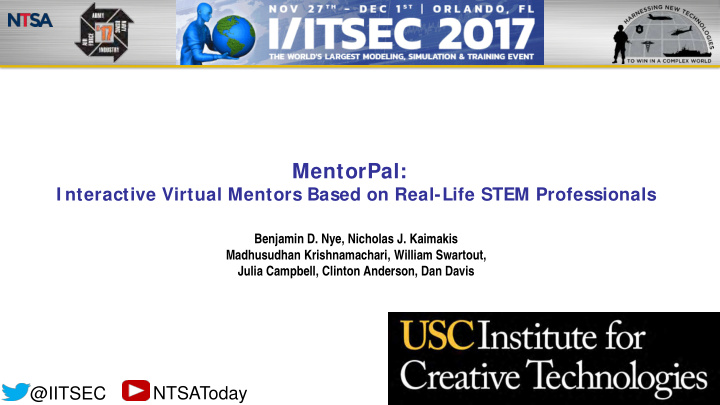



MentorPal: I nteractive Virtual Mentors Based on Real-Life STEM Professionals Benjamin D. Nye, Nicholas J. Kaimakis Madhusudhan Krishnamachari, William Swartout, Julia Campbell, Clinton Anderson, Dan Davis @IITSEC NTSAToday
The Problem @IITSEC NTSAToday 2
Mentorship “Mentoring is a brain to pick, an ear to listen, and a push in the right direction.” — John Crosby But: Mentors are difficult to find • Certain demographics lack access to mentors • Mentorship programs lack scalability • @IITSEC NTSAToday 3
The Solution MentorPal • Virtual mentors for high school age students, scaled An interactive virtual agent that allows students to ask their own questions • • Tablet based chat system Mentors handpicked for their diverse set of experiences and mentoring ability • @IITSEC NTSAToday
Background and Related Projects New Dimensions in Testimony (NDT) • • 1400 answers could answer 70% of questions and 2000 would cover 95% • Can we reduce cost of such a system while maintaining effectiveness and also scale up? Personal Assistant for Life-Long Learning (PAL3) • • Creates an interactive, personal guide for learning for Navy sailors as they progress in their career @IITSEC NTSAToday
Goals Provide engaging, relevant responses for students interested in STEM fields 1. Create a low-cost, repeatable process that allows for scalability without 2. significant loss of quality @IITSEC NTSAToday 6
I nteraction @IITSEC NTSAToday 7
Choosing a Mentor Criteria: • Relevant experience in STEM fields • Engaging and personable • Ability to provide useful advice in an eloquent manner @IITSEC NTSAToday 8
Mentoring Topics and Questions Accumulate questions 1. Develop criteria for assessing question quality 2. Rank questions 3. Categorize questions into topics 4. @IITSEC NTSAToday 9
What qualities make a good response? Emotional 1. Narrative 2. Answers frequently asked questions 3. Provides valuable information 4. @IITSEC NTSAToday 10
Question Topics @IITSEC NTSAToday 11
I nterview Process • Choose mentor • Provide mentors with equipment and setup instructions • Total equipment cost: $235 • Record five 3-hour interview sessions based on question framework • Follow up questions asked in-session and in later sessions @IITSEC NTSAToday 12
Dialogue Model and Development Process for Creating Corpus of Question-Answer Data for a Mentor @IITSEC NTSAToday 13
Special Cases • What happens when a user doesn’t ask a question for a while? • How should irrelevant questions be handled? • What if the user repeats questions? • Deviation from agenda @IITSEC NTSAToday 14
I nitial Accuracy Results Dialogue Model NDT (Train: 10000, Test: 400) MentorPal (Train: 1600, Test: 200) NPCEditor 0.734 0.392 Classifier - 0.471 Ensemble - 0.466 @IITSEC NTSAToday 15
User I nteraction and I nterface @IITSEC NTSAToday 16
I nterface with Transcriptions @IITSEC NTSAToday
Mentor Panel @IITSEC NTSAToday 18
Future The goal of MentorPal is to increase the realism of a student’s career goals In a large-scale setup, a student would be able to talk to multiple mentors in the same field and receive several points of view MentorPal offers greater breadth, but less depth Dialogue model can be replicated Cost of scaling up is low, and we aim to streamline the system to make a ‘MentorPal Recorder’ that can be used by anyone to build such mentors simply by entering questions and recording @IITSEC NTSAToday 19
Questions? @IITSEC NTSAToday 20
Recommend
More recommend